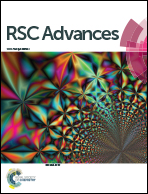Highly efficient gold nanoparticle dimer formation via DNA hybridization†
Abstract
Gold nanoparticles (AuNPs) have been widely investigated and their peculiar properties have been exploited for important applications, such as Raman spectroscopy, biological sensing or medical therapy. AuNPs are characterized by well defined plasmon optical resonance and scattering features and there are well established protocols for chemical functionalization. Among the latter, DNA self assembly has been demonstrated as an excellent way to assemble nanoparticle structures with controlled shape and dimensions. This approach was applied for optical properties engineering, plasmonic hot spots in AuNP aggregates, and molecular rulers in AuNP dimers in which the interparticle distance was controlled with nm precision. Here we compare two effective strategies toward the efficient formation of gold nanoparticle dimers using DNA hybridization. Direct aggregation uses a partial surface passivation of fully ssDNA coated AuNPs to control interparticle hybridization; disaggregation, instead, forms AuNP dimers in a two step process in which ssDNA coated NPs are first fully aggregated and precipitated and then re-suspended with the addition of a controlled amount of one or both complementary sequences. This latter approach provides a dimer yield as high as 26% of the overall initial amount of AuNPs, the highest reported in the literature, also with DNA sequences as short as 11 nucleotides (nts), with promising implications for Raman enhancement applications.


 Please wait while we load your content...
Please wait while we load your content...